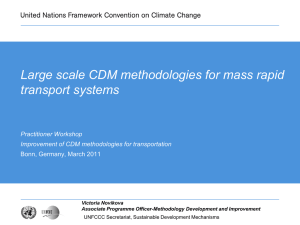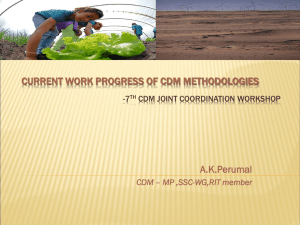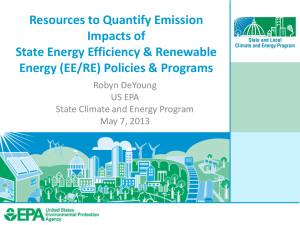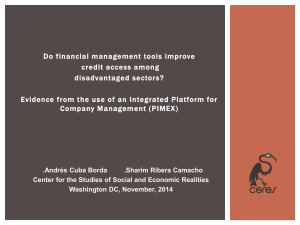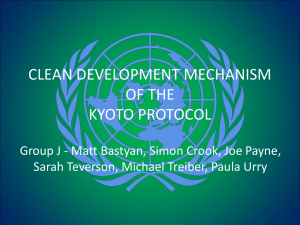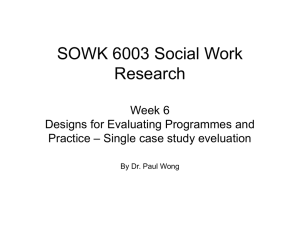Project - Carbon Finance at the World Bank
advertisement
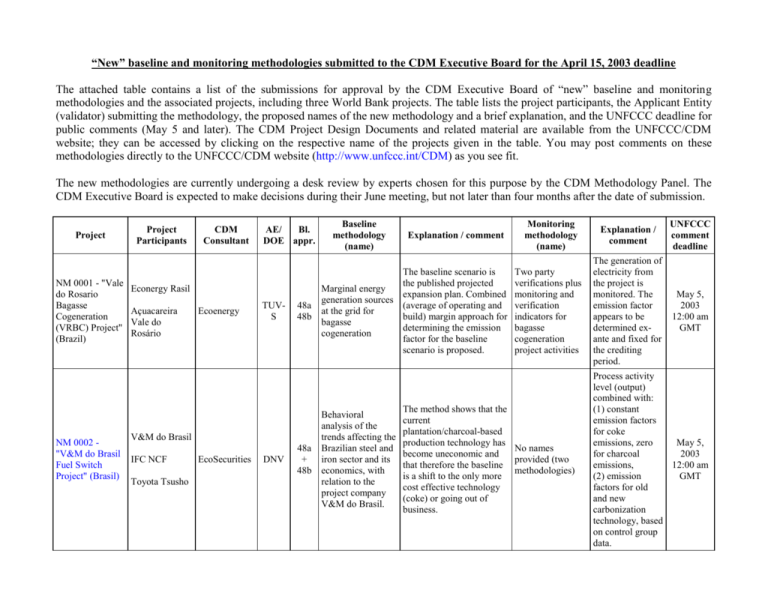
“New” baseline and monitoring methodologies submitted to the CDM Executive Board for the April 15, 2003 deadline The attached table contains a list of the submissions for approval by the CDM Executive Board of “new” baseline and monitoring methodologies and the associated projects, including three World Bank projects. The table lists the project participants, the Applicant Entity (validator) submitting the methodology, the proposed names of the new methodology and a brief explanation, and the UNFCCC deadline for public comments (May 5 and later). The CDM Project Design Documents and related material are available from the UNFCCC/CDM website; they can be accessed by clicking on the respective name of the projects given in the table. You may post comments on these methodologies directly to the UNFCCC/CDM website (http://www.unfccc.int/CDM) as you see fit. The new methodologies are currently undergoing a desk review by experts chosen for this purpose by the CDM Methodology Panel. The CDM Executive Board is expected to make decisions during their June meeting, but not later than four months after the date of submission. Project NM 0001 - "Vale do Rosario Bagasse Cogeneration (VRBC) Project" (Brazil) NM 0002 "V&M do Brasil Fuel Switch Project" (Brasil) Project Participants CDM Consultant AE/ Bl. DOE appr. Econergy Rasil Açuacareira Vale do Rosário Ecoenergy TUVS 48a 48b V&M do Brasil IFC NCF Toyota Tsusho EcoSecurities DNV 48a + 48b Baseline methodology (name) Explanation / comment The baseline scenario is the published projected Marginal energy expansion plan. Combined generation sources (average of operating and at the grid for build) margin approach for bagasse determining the emission cogeneration factor for the baseline scenario is proposed. Behavioral analysis of the trends affecting the Brazilian steel and iron sector and its economics, with relation to the project company V&M do Brasil. Monitoring methodology (name) Two party verifications plus monitoring and verification indicators for bagasse cogeneration project activities The method shows that the current plantation/charcoal-based production technology has No names become uneconomic and provided (two that therefore the baseline methodologies) is a shift to the only more cost effective technology (coke) or going out of business. Explanation / comment UNFCCC comment deadline The generation of electricity from the project is monitored. The emission factor appears to be determined exante and fixed for the crediting period. May 5, 2003 12:00 am GMT Process activity level (output) combined with: (1) constant emission factors for coke emissions, zero May 5, for charcoal 2003 emissions, 12:00 am (2) emission GMT factors for old and new carbonization technology, based on control group data. Project NM 0003 - " Construction of new methanol production plant (called: M 5000) in the Republic of Trinidad and Tobago" NM 0004 - " Salvador da Bahia Landfill Gas Project" (Brasil) NM 0005 - " NovaGerar landfill Gas to Energy Project" (Brasil) Project Participants Ferrostahl AG (Germany) Methanol Holdings (Trinidad) CDM Consultant Hamburg Institute of International Economics AE/ Bl. DOE appr. TUVS SUEZ Environnement ICF DNV VEGA S.A. NCDF (Netherlands) EcoSecurities World Bank Carbon Finance EcoSecurities DNV 48c Baseline methodology (name) Explanation / comment The baseline methodology is to use the carbon intensity of top 20% of Improvement of methanol production carbon intensity of facilities over the past 5 new methanol years to determine the production plants differential emission based on steam factor. This, and the reforming project activity level, is used to determine the emission reduction. The baseline emission level is defined by the level of LFG capture agreed to by contracted company and local government. 48b + 48c Legal obligation for landfill gas capture and flaring defined through public contract. 48b The suggested methodology uses the internal rate of return Simplified (IRR), or the net present financial analysis value (NPV), calculation for an investment to assess the financial project where attractiveness of the business-as-usual project and to determine is the only other whether the investment for plausible which the IRR has been alternative scenario calculated is likely to be made given the forecasted rate of return from the investment. Monitoring methodology (name) Explanation / comment UNFCCC comment deadline Monitoring of methanol production parameters Project activity levels (to calculate CO2 emissions) are monitored. Average carbon intensity of similar plants is calculated based on secondary data. May 8, 2003 12:00 am GMT No name given. It is pointed out, however, that the methodology is a refined version of the one that ICF developed for the PCF in the Latvia Liepaja LFG Project. The methodology is commonly used in landfills with gas to energy plant May 6, 2003 12:00 am GMT Direct monitoring and calculation of ERs in landfill gas utilization or flaring projects The methodology is commonly used for landfill gas-to-energy projects (see NM 0010) May 6, 2003 12:00 am GMT Project NM 0006 - " Guatemala El Canada Hydoelectric Project" (Guatemala) Project Participants PCF EnergiaGlobal INEOS Fluor NM 0007 - " Japan HFC Decomposition Foosung Tech Project in Ulsan" Corporation (South Korea) Korea NM 0008 "Peñas Blancas Hydroelectric Project" (Costa Rica) CDM Consultant PCF Consultant Climate Experts (Japan) AE/ Bl. DOE appr. DNV Japan QA Assoc. Costa Rica OCIC DNV Explanation / comment 48b The baseline is the country’s electric system plus its expansion. A cost comparison Least cost analysis ($/kWh) with a suitable of power capacity plant of similar operational expansion characteristics shows that the project is more expensive and is therefore not part of baseline. 48a + 48b Methodology for decomposition of HFCs in a nonregulated country The suggested methodology assumes that the added costs of destruction of industrial gases creates an economic disincentive to prevent their emission to the atmosphere and that therefore business as usual is the baseline. 48a + 48b The baseline is expressed as a (10-year) fixed grid CERUPT Dispatch emission factor, Analysis determined using a Methodology for dispatch model and Grid-Connected expected operational Electricity Projects conditions and capacity additions (key factor analysis). ICE CERUPT Baseline methodology (name) Monitoring methodology (name) Explanation / comment Monitoring of dispatch data to be used to Marginal dispatch calculate analysis in emissions integrated electric associated with power systems power not dispatched due to the project. Monitoring methodology for decomposition of HFCs in a nonregulated country UNFCCC comment deadline May 6, 2003 12:00 am GMT Direct monitoring May 8, and calculation 2003 of the amount of 12:00 am destructed GMT industrial gases. Monitoring of the project’s electric CERUPT output and (if monitoring any) the project’s methodology for emissions and grid-connected leakage, used electricity projects with the grid emission factor to calculate ERs. May 8, 2003 12:00 am GMT Project NM 0010 "Durban Landfill-gas-toelectricity project" (South Africa) NM 0011 - "26 MW Bagasse / Biomass based Cogeneration Power Project" (India) NM 0012 Wigton Wind Farm project (Jamaica) Project Participants CDM Consultant Monitoring methodology (name) Explanation / comment UNFCCC comment deadline 48b The baseline is the BAU Cost and scenario (landfills), investment determined by excluding analysis for other options and electricity autocomparing the project’s generation (e.g. by power generation costs municipalities) with the (expected) tariff paid by the municipality. (1) Direct monitoring and calculation of ERs in landfill gas utilization or flaring projects. (2) Use of average annual carbon emission intensity factor for the grid. (1) Direct and indirect metering of landfill gas / CH4 combusted or flared. (= NM 0005) (2) Use of method depends on appropriate grid and project characteristics and published grid emissions and power output data. May 9, 2003 12:00 am GMT 48a The baseline scenario is based on the officially The weighted published expansion plan average emissions relevant to the province in of current which the project is generation mix located. Projected excluding generation from the power historically plants in the expansion identified must run plan (eliminating the mustprojects run power plants) is used to determine emissions from the baseline scenario. Baseline emissions are Electricity fixed ex-ante generation from based on the project will be expected monitored. projected Baseline generations and emissions are not selected emission monitored. factors from operating plants. May 9, 2003 12:00 am GMT 48a Recent capacity addition to the existing grid is proposed as the baseline. It Recent additions to is not clear if future the grid. PDD also capacity addition are states that the envisaged and included in methodology the baseline scenario. resembles the Capacity additions over approach in the past 5 years are used to paragraph 48(c). estimate the weighted average emission factor for the baseline scenario. The emission factor for the baseline scenario (the Jamaican Direct monitoring grid without the of electrical project) is output of wind determined exfarms ante and it appears will not be monitored or determined ex post. May 9, 2003 12:00 am GMT AE/ Bl. DOE appr. Durban Municipality PCF PCF Consultant TUVS South Africa SCM Sugars, India Unspecified consultants TUVS India Renewable Energy Systems (RES) RES and Petroleum Corp EcoSecurities of Jamaica NEC Micon Jamaica SGS Baseline methodology (name) Explanation / comment Project Project Participants CDM Consultant Explanation / comment Monitoring methodology (name) Official data used to establish the weighted average CO2 emissions of the grid on an ex-post basis. Monitoring emissions from biomass power generation using direct measurements and commercial records The approach uses a mix of official power May 9, statistics and 2003 standard emission 12:00 am factors. Heavy GMT reliance on commercial records. 48a Displacement of steam generated from the combustion of fossil fuels: Energy balance calculation for displaced steam where the displaced fuel(s) and technology(ies) are known. The baseline is the emissions from combustion of fuels needed to produce steam Monitoring emissions from biomass steam generation using direct measurements and commercial records The approach uses a mix of official power May 9, statistics and 2003 standard emission 12:00 am factors. Heavy GMT reliance on commercial records 48a Estimation of emission reductions from uncontrolled biomass disposal where BAU is open air burning. Baseline is uncontrolled burning of biomass. The methodology is intended for projects that reduce emissions from dumping or uncontrolled burning that would otherwise occur. Monitoring emissions from biomass energy generation and methane avoidance. The approach uses a mix of official power May 9, statistics and 2003 standard emission 12:00 am factors. Heavy GMT reliance on commercial records AE/ Bl. DOE appr. A.T. Biopower NM 0009 - AT Biopower Rice Husk Power Project in Thailand Displacement of grid electricity NM 0014 - AT Biopower Rice Husk Power Project in Thailand Displacement of steam NM 0015 - AT Biopower Rice Husk Power Project in Thailand Methane avoidance Mitsubishi Securities Rolls-Royce Mitsubishi Securities DNV 48a Al Tayyar Energy See NM 0009 See NM 0009 See NM 0009 See NM 0009 Baseline methodology (name) Displacement of grid electricity: Retrospective annual application of weighted average carbon emission factors calculated from actual official data. Explanation / comment UNFCCC comment deadline
